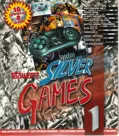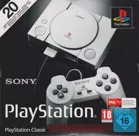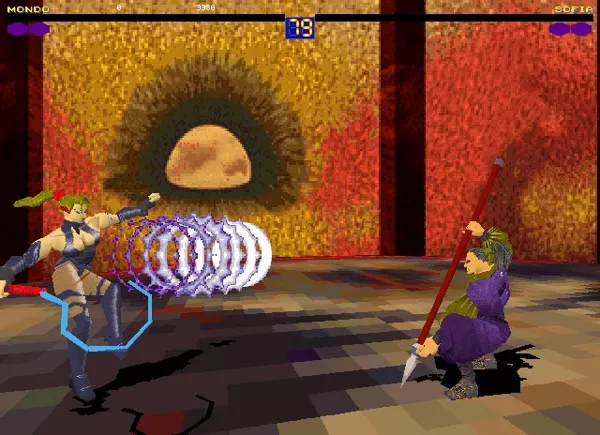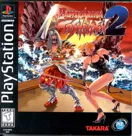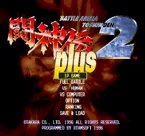Battle Arena Toshinden
Description official descriptions
In Battle Arena Toshinden eight world renown weapon fighters have been invited to a mysterious tournament. It is one of the first one-on-one beat-em-ups to feature the ability to sidestep a full 360 degrees around the opponent allowing one to strike from any angle. Aside from the 3D movement, Toshinden's game play can be considered similar to Street Fighter, but in 3d and with a little less depth to the moves.
Two versions of Toshinden were released; for the Sony PlayStation and later a lesser known version for DOS PC's. However the PC version is not a straight port of the PlayStation version and plays and looks notably different despite sharing the same characters, attacks and controls.
The U.S and E.U PlayStation versions of Toshinden feature redone voices in English and redone music using different instruments.
The lyrics on Sofia's stage music in the Japanese version, which were actually in English, were removed in the process, likely due to their suggestive nature.
Sofia's and Ellis' voices in the English translation are also notably adjusted, for presumably the same reason; while the other characters English voices generally match the tones of the original Japanese voice actors, Sofia is far less suggestive sounding, while Ellis sounds notably older.
The later DOS version of Toshinden however, uses the same audio as the Japanese PlayStation version in all regions, albeit recorded at a considerably lower quality than they were on PlayStation.
Spellings
- 闘神伝 - Japanese spelling
Groups +
Screenshots
Promos
Credits (PlayStation version)
46 People (28 developers, 18 thanks) · View all
| Producer | |
| Director | |
| Main Programmer | |
| Production Designer | |
| Game Character Design | |
| Original Character Design | |
| Sound Supervisor | |
| Director of Story Board | |
| Artwork Design | |
| Sub Program | |
| Motion Compose | |
| Motion Design |
|
| Background Design | |
| Assistant Design |
|
| Sound Effect | |
| Music | |
| Data Converter | |
| Adviser |
|
| General Affair | |
| [ full credits ] | |
Reviews
Critics
Average score: 75% (based on 43 ratings)
Players
Average score: 3.4 out of 5 (based on 33 ratings with 2 reviews)
It takes more than a whip-wielding dominatrix to make a successful fighting game
The Good
Toshinden is sort of a rarity in the world of console fighting games in the sense that nobody can explain how it ever managed to become such a success. Ok, it's not a blockbuster franchise, but it did sell quite a few copies and has more sequels and ports than I'd care to count.
The simple answer is that it was a first generation psx-title, and as such the only option available if you wanted 3D fighting action with weapons a-la Samurai Shodown, yet that doesn't explain how the game got ported to the PC instead of other titles like Tekken, yet that's exactly what it did. Ported by god knows who, Toshinden and it's merry band of fighters landed on Dos back in the days when 3D accelerators were starting to become a trend. To it's credit, making a 3D accelerated game in those pre-Direct3D days was nothing short of nightmarish, yet Toshinden came with a functional software engine as well as a multitude of first generation 3D cards to use should you have one, and as far as graphics go, it was a pretty safe bet that you weren't gonna find a better looking option for your PC.
Also available are plenty of multiplayer options such as modem/network play which allow you to extend the life of the game considerably should you find someone else that somehow got stuck with a copy of it and is willing to play it.
The Bad
It sucks ass, plain and simple. As explained it's moderate success can be blamed on the fact that the PSX had about 2 other fighting games at the time, but that's it, if you think it's one of those fantastic console-only titles that somehow got ported to the PC you are absolutely wrong.
Basically what you have here is a lame-ass Virtua Fighter clone with a more arcadey feel and the addition of weapons. Ever heard of Soul Blade/Edge/Calibur? Well, that's it. Only Toshinden manages to take the premise and render it useless by placing it under the hood of a boring, slow-paced fighting game.
For starters the characters are horribly clichéd (right down to the identical Ryu-Ken main characters) and unoriginal, with only a whip-wielding, tit-bouncing dominatrix to arouse your interest, the rest are all Tekken rejects. Not only that, but there's no story or development whatsoever so as to make them a little more charismatic. Worse yet: balance is pretty much inexistent, with some characters being almost embarrasingly easy to win with, and others that are almost impossible to use.
Moves are simple and straightforward, but they lack the finesse in execution and animation of VF, and the spectacular flashy effects of Tekken, so they end up rendering the gameplay pretty ho-hum (except for the "desperation moves" unique to each character that are much flashier than their regular counterparts). Sound is terrible, with nauseating midi music and garbled voiceovers and effects, etc. etc.
About the only thing that Toshinden does right are the graphics, but one look to it by today's standards and you'll swear them off as prehistoric crap with only rudimentary textures to separate them from earlier efforts like FX Fighter or the original VF.
The Bottom Line
It's somewhat depressing to see lousy games somehow ported to another platform when better and more successful titles get the shaft and become exclusive properties of X platform, but that's exactly what happened here. I know there has always been a shortage of good fighting games for the PC, but Toshinden is NOT a good fighting game, so just move along and pretend it's not there.
DOS · by Zovni (10502) · 2004
The Good
The graphics hold up pretty well, considering the game is 20 years old. The character model are better than Virtua Fighter and arguably as good, if not better than those in Tekken 1. The arenas are also fully 3D and feature ring outs, which was a fairly rare feature in 1995.
The characters are pretty good. The English version has cheesy accents dubbed on, Duke speaks with a French accent, Rungo sounds like a caveman. All good fun. Sofia has a long whip and reminds me of Poison from the Capcom games. Eiji is the generic "Ryu" of the game. There's an old man called Fo who has claws, he lacks the charm of Shun from Virtua Fighter or the coolness of clawed Voldo from Soul Edge. And that's one of the games' shortfalls the characters are cool, but forgettable.
The Bad
The game's special moves are more complicated than they should be, often quarter circle forward and an attack button. While you would expect this in Mortal Kombat, the moves are hard to pull off consistently, due to the games below average collision detection. If playing against the computer AI, the game will often allow the AI the first hit, even if you executed it first. The final boss is also incredibly strong with the ability to pull off multiple fireballs which do 50% damage if all of them hit. The characters are unbalanced in terms of difficulty, one character has an incredibly long staff weapon that can reach across the arena. For whatever reason games like Tekken seemed balanced, even hard bosses like Hitachi seemed beatable. The weapons were evenly balanced in Soul Edge, even if some were long or short-ranged, they all seemed fairly matched.
Stage music is J-Pop techno, think Ridge Racer music, but nowhere near as good or memorable. Mainly corny tunes. There's a few rock tracks, these are also generic and forgettable.
The Bottom Line
Battle Arena Toshinden was a very early game in what turned out to be Playstation's massive library. It is forgettable and often frustrating. It has some unique features for the time, such as real 3D arenas and a roll the player can use to dodge fireballs or other attacks. Compared to Virtua Fighter or Tekken it lacks the polish and indefinable X-Factor that made them classics.
I would recommend it to beat 'em up fans or serious Playstation collectors that want to explore the system's early games. The game has a cult following, but there are loads of much better fighters on the PS1.
PlayStation · by Alex L (1000) · 2015
Trivia
Earthworm Jim
The DOS version includes Earthworm Jim as a playable character. This is because of the deal that Playmates (publisher of the first two Earthworm Jim games) and Takara (developer of the Battle Arena Toshinden series) had made: whileTakara would publish the Earthworm Jim games in Japan, Playmates would publish Toshinden 2 & 3 in the US, and also handle the DOS port of the original Battle Arena Toshinden.
Rungo
The character select screen in the Japanese PlayStation version incorrectly spells "Rungo" as "Run Go". Presumably this was a mistake as the manual spells it "Rungo". This was corrected for the US and European releases.
Information also contributed by Verm --.
Analytics
Upgrade to MobyPro to view research rankings and price history! (when applicable)
Related Sites +
-
Battle Arena Toshinden Art Tribute
A group of artists created an art tribute for all Battle Arena Toshinden characters -
Battle Arena Toshinden Fandom
Fandom about Battle Arena Toshinden series.
Identifiers +
Contribute
Are you familiar with this game? Help document and preserve this entry in video game history! If your contribution is approved, you will earn points and be credited as a contributor.
Contributors to this Entry
Game added by Alexander Schaefer.
PlayStation added by etempest.
Additional contributors: Jeanne, Игги Друге, Lance Boyle, Patrick Bregger, R H, cjuni.
Game added May 4, 2002. Last modified May 24, 2024.





